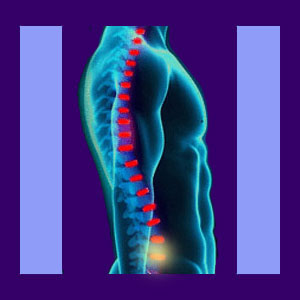
Experiencing sciatica from compression fracture is a common problem, especially in elderly and obese patient demographics. Compression fractures often occur in the lumbar region, particularly at L4 and L5, potentially creating neurological problems involving some of the nerve roots (L4, L5, S1, S2 or S3) that go on to form the sciatic nerve.
Compression fractures can occur for many reasons and may or may not be painful. Many patients have fractures that do not create pain and do not require any treatment. Other patients have painful fractures that will resolve by themselves. Some fractures are not painful, but can diminish the patency of the central or foraminal canals, potentially causing many of the alternative expressions of sciatica, such as paresthesia and weakness. Other fractures are painful and also create the types of neurological deficits detailed above. There are many possible combinations of symptomology when it comes to compression fractures, so each must be evaluated and treated on a case-by-case basis.
This guide helps patients to better understand the relationship between lumbar compression-type vertebral fracture and the incidence of sciatica symptoms in the lower body. We will also discuss cases where fractures elsewhere in the spinal anatomy can create sciatica-type symptoms through direct compressive influence on the spinal cord. If you are suffering sciatica from compression fracture of one or more vertebral bones, this discussion is perfect for your research needs.
Sciatica from Compression Fracture Explanation
Compression fractures are defined as injuries that can occur simply due to the weight of the body pressing continuously down on the spine, causing bones to break, splinter or even completely lose structural integrity, often affecting the stability of the entire vertebral column in the worst instances. Compression fractures might occur slowly over time or might be hastened into acute expressions by lifestyle factors, such as aging, weight gain, bone density loss or disease, as well as exposure to traumatic forces, such as falls, car accidents and other traumas.
When a vertebral bone fractures, the results range greatly, from minor structural damage to virtually complete disintegration of the vertebral structure. Obviously, this wide span of fracture types will also produce an even broader range of possible symptoms, ranging from none to the worst possible spinal instability conditions, complete with intractable pain, possible paralysis or other neurological effects, such as incontinence.
People at the most risk for suffering sciatica from compression fracture in the spine are the elderly, those with osteopenia or osteoporosis, obese individuals, people with certain bone disorders, people with certain nutritional deficits and people who must tolerate considerable spinal loading due to work or recurrent lifestyle activity.
True Sciatica from Fractured Vertebrae
In order for true sciatica to occur, the compression break must occur in the lumbar spine and affect one or more of the lumbar or sacral nerve roots directly. Lower lumbar fractures are very common, since these levels suffer marked degeneration and considerable chronic stress as a natural part of their lifespan.
In patients who are elderly, patients with bone density problems and obese patients, the strain on the lumbar bones can cause fractures without any trauma taking place. Remember, the lumbar spinal region supports the entire upper body, which can be a very heavy burden to bear for a weakened anatomy. Of course if an injury does occur, the chance of suffering a fracture in the lumbar spine increases dramatically in these susceptible patient populations. Compression fractures in the lumbar area can cause sciatica due to 2 distinct scenarios that may occur independently or in combination with one another:
Some fractures might reduce the patency of one or more of the neuroforaminal openings through which the lumbar nerve roots exit the spine. This can produce pinched nerve symptoms and might even produce widespread sciatica, especially when more than one root is impinged upon by vertebral debris.
Other fractures can actually compress the entire cauda equina structure, as a grouping, potentially causing very severe cauda equina syndrome symptoms including pain, tingling, numbness and weakness in the buttocks and legs, as well as sexual dysfunction, incontinence and the inability to stand or walk for long, or at all. Some patients suffer temporary or permanent degrees of incomplete paralysis as a result of cauda equina compression.
Pseudo-Sciatica from Spinal Fracture
Compression fractures that occur elsewhere in the spinal anatomy, such as in the thoracic or cervical regions, can also cause sciatica-type expressions, commonly termed pseudo-sciatica. Although these symptoms are not generated due to influence on the L4, L5, S1, S2 or S3 nerve roots, they can mirror actual sciatica in virtually every way.
When compression breaks occur elsewhere in the spine, they can enact these pseudo-sciatica problems due to central spinal stenosis that obstructs the primary vertebral canal. When this stenosis is severe, the spinal cord can become displaced or impinged upon and in the worst instances, can even become compressed.
A compressed spinal cord might influence the motor, autonomic and sensory capabilities of the entire body below the impinged levels. This can create far-ranging symptoms, including sciatica, various types of paralysis and many internal organ deficits, as well. The higher up in the spinal anatomy the fracture resides, the more areas of the body might be affected by the stenotic effects on the spinal cord.
Compression fractures are very common in the thoracic and cervical regions in the same patient demographics detailed previously in this essay. In the cervical levels, the bones bear much less actual weight, but still must cope with tremendous force from the movement of the head, as well as the lighter structure of the cervical vertebral bones. The thoracic levels are reinforced by the rib cage, so they are very strong. However, when a patient experiences a thoracic compression break, severe symptoms might result, including central stenosis and general anatomical instability in the upper body.
Prevention of Sciatica from Compression Fracture
Sciatica from compression fracture can often be prevented through proper health practices and wellness monitoring. To this end, we recommend keeping the following considerations in mind to prevent fractures, rather than experience the need for potentially dangerous treatment of existing fractures:
Keep your body height and weight proportionate. Really be careful of developing “hot spots” of extra weight, such as a large gut that will place tremendous stress on the lumbar spine.
Eat healthily and be sure to ingest a complete diet of all the vitamins and minerals needed to build a strong and durable spine.
Maintain good posture in all anatomical positions, including reclining, sitting and standing to equally distribute spinal stresses.
Be certain to monitor bone density as you get older or if you have special circumstances that predispose you towards porous bones. There are many solutions for bone density problems that can prevent fractures from occurring.
If you do demonstrate risk factors for compression fracture, be careful with your body and avoid activities that place inordinate and chronic stress on particular regions of the spine.
To learn more about how compression fractures can cause back and neck pain, please use our search bar to find the many topical articles we have shared previously on the various sites of The Cure Back Pain Network.
Sciatica > Sciatica Causes > Sciatica from Compression Fracture






